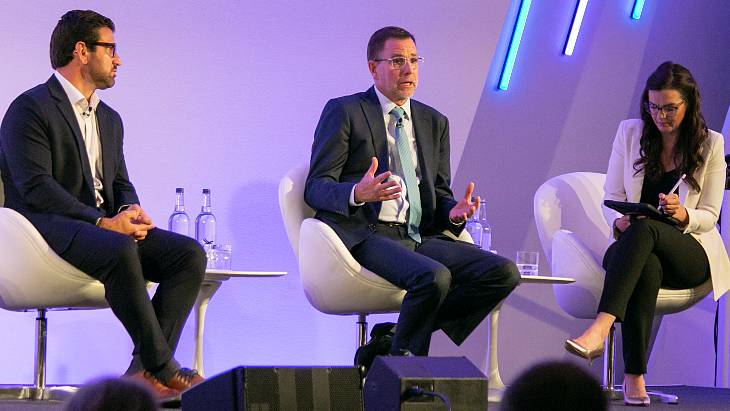'Huge demand for SMRs’ - so what are the key challenges?
21 September 2022
The interest in small modular reactors (SMRs) means that building the industrial capacity to produce the numbers required is just one of the challenges for companies as they turn their visions into reality, World Nuclear Symposium heard.
 Rick Springman, left, Jon Ball, centre, with host Fran Scott (Image: World Nuclear Association)
Rick Springman, left, Jon Ball, centre, with host Fran Scott (Image: World Nuclear Association)Both Jon Ball, executive vice president market development for GE Hitachi Nuclear Energy, and Rick Springman, senior vice president of international projects for Holtec International, set out their aims to have SMRs operational within the next ten years during a panel session on Turning Vision into Reality at the nuclear industry’s gathering in London earlier this month.
Ball said that "really large numbers of reactors are going to be needed to solve both the climate change crisis but also the energy security crisis … massive numbers are needed, and we can debate what’s going to be the right number but we know it’s going to be a lot". He said that when GE Hitachi talks to potential customers about its BWRX-300 SMR "they’re not talking about one or two reactors, it’s ‘we need 10 or 20 of these reactors'".
The scale of demand means there will be pinch points in order to meet the required numbers, Ball said, such as forgings and reactor pressure vessels: "There’s limited capacity today but is it insurmountable? It’s not. We know how to do it, it’s just a matter of building up that capacity and there needs to be a clear demand signal - ultimately these suppliers, these manufacturers, want to see real orders so that they feel comfortable investing in their plants to increase capacity."
Ball added that, because the BWRX-300 is essentially a 10th evolution BWR with the same components, same fuel and same way of performing outages, they are hiring and training up workers for the SMRs - which the company hopes to have operational from 2028 - working on their existing reactors. They have also got virtual reality capacity so people can "walk" through the plant in 3D.
The other area which will have a huge influence on the SMR roll-out was "optimum harmonisation" of regulation, with the example of the US and Canadian regulators cited as an example to be applauded, while, Ball said, it was encouraging to see countries new to nuclear "really reaching in for guidance".
Holtec’s Rick Springman said the company has a "long-term view with a near-term focus to get ready for what we perceive as a huge future market". He said that the company had put its own money in and was fully committed to developing a new breed of "absolutely safe, small module reactors - that's essentially what we've been working on for the last 10 years". He added that its reactors work passively with "all the emergency cooling water that it needs to shut down indefinitely" without the need for off-site power.
He said that the firm currently sees the first commercial operation of an SMR-160 at the Oyster Creek site in the USA by 2030, although that timetable might be accelerated. He stressed that a key development goal had been to ensure it was "operation-friendly - this is an 80-year machine, it has to be operation-friendly" so that people want to use it.
Springman also flagged the challenges of financing new nuclear projects, especially internationally with a first-of-a-kind product. Other industries, he noted, could cover the gap with technology risk insurance.
He said that Holtec expected to eventually need at least four SMR manufacturing industrial sites around the world - each producing around four SMRs a year - to meet demand, with the company "in discussions with a lot of utilities in the US and abroad".
Another key issue, Springman said, was that nuclear energy needed to have a "proper valuation" reflecting that it is "providing something unique that no other technology can provide - 24/7 clean energy". He said that energy market regulators should ensure that the reliability and clean energy offered was suitably reflected in the market.
This issue was also raised by Keith Everhart, from the International Energy Agency, who said their calculations suggested that robust carbon pricing, combined with scarcity pricing would mean that from the energy markets at least four technologies - solar, wind and hydro as well as nuclear - would be able to meet their on-going costs and costs of new investment.
Researched and written by World Nuclear News
No comments:
Post a Comment